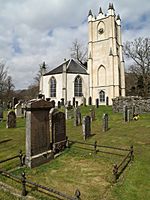Glenorchy Parish Church facts for kids
Quick facts for kids Glenorchy Parish Church |
|
|---|---|

Glenorchy Parish Church and Graveyard
|
|
| Lua error in Module:Location_map at line 420: attempt to index field 'wikibase' (a nil value). | |
| Location | Dalmally |
| Country | Scotland |
| Denomination | Church of Scotland |
| Website | www.glenorchyparish.org.uk |
| History | |
| Status | Parish church |
| Architecture | |
| Functional status | Active |
| Heritage designation | Category A listed building |
| Designated | 20 July 1971 |
| Architect(s) | James Elliot |
| Style | Gothic Revival |
| Completed | 1811 |
Glenorchy Parish Church is a church in the village of Dalmally, Argyll and Bute, Scotland. It belongs to the Church of Scotland. This church serves the area known as Glenorchy and Inishail. People also call it Glenorchy Kirk. Long ago, it was known as the Church of Dysart.
The church building is shaped like an octagon, which means it has eight sides. It was built in the early 1800s. This special building is protected as a Category A listed building. This means it is very important historically. The church is also known for its old burial ground and special grave slabs.
Contents
Where is Glenorchy Parish Church?
The church stands on a small island. This island was formed by the River Orchy. It is located in Dalmally, in western Scotland. The church is close to the A85 road. You can also reach it by train at Dalmally railway station.
The Gallow Hill and Saint Conan's Well
Across from the church is the Gallow Hill of Glenorchy. Old stories say this hill was a place where the Macgregors used to carry out quick punishments. Near the church, there is also a holy well. It is called the well of Saint Conan.
About Glenorchy Parish
The area known as Glenorchy parish is located between Perthshire to the east. To the west, it is near Lochawe and Loch Etive. This parish was created in 1618. At that time, the areas of Glenorchy and Inishail were joined together.
The main valleys in Glenorchy parish are Glenstrae, Glen Orchy, and Glen Lochay. In the middle of the parish, you will find Loch Tulla. Loch Lydon is to the north, and Loch Awe is to the south.
History of the Church
Records mention the church as early as 1390. Iain Macgregor of Glenorchy, a mountain chief, was buried there. He was laid to rest on the north side of the High Altar in Dysart. More records from 1449, 1498, and 1523 also talk about the church.
In 1586, the church was described as being on an island. This island was naturally surrounded by the water of the River Vrquhay (Orchy). In 1614, Sir Duncan Campbell paid to use the church for many years.
The Current Building
The church building you see today was built in 1811. It was designed by an architect named James Elliot from Edinburgh. Even in 1860, the older church building was still standing nearby. The famous Scottish Gaelic poet, Duncan Ban MacIntyre, lived about 15 miles away. Glenorchy Parish Church was the closest church to him.
Church Building Design
The church building has an eight-sided shape. It is built in the Gothic style. The roof is also eight-sided and made of slate. A square Gothic tower is attached to the church. Some of the church's pointed windows were fixed in 2008.
Church Grounds and Gravestones
The churchyard is a burial place. It was where many members of the Macgregor family were buried. You can also find very old grave slabs in the church's burial ground. These slabs are from the Late Middle Ages. They have carvings of armed warriors and special symbols. It is believed these gravestones were brought from Inishail.

